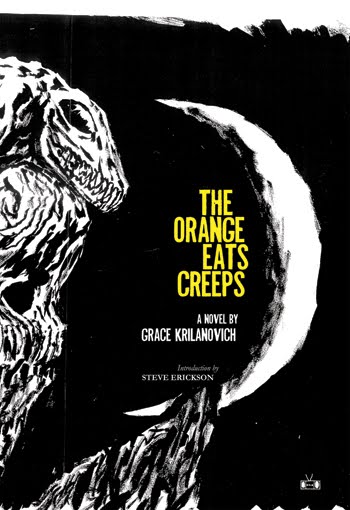
Dingy supermarket aisles bleed into the rot of primordial forests without explanation. A bus driver’s jugular is bitten and a stream of robutussin pulses out in lieu of blood. The frenzy of the present effortlessly folds into pages of muddied nostalgia. In Grace Krilanovich’s debut novel, Orange Eats Creeps there is only one boundary: the sense of isolation felt by the unnamed first person narrator. Her contained view of the world is never breached. A flood of different characters pass through her life that she sucks, grinds, and kills- but any sense of human connection is completely absent.
Orange Eats Creeps is about a band of young vampires in the Pacific Northwest. It isn’t anything like the Twilight series, also about Vampires in the NW and coincidentally the last piece of literature reviewed by the Catalyst. Krilanovich’s vampires have none of the expected sheen, they are “Slutty Teenage Hobo Vampire Junkies”. They are spreading Hepatitis, sleeping in garage meth labs, and guzzling cold coffee from white buckets. They’re an interpretation of the sizeable population of young run-aways that populate the Pacific Northwest. They’re the crust punks that stole your friends xbox when they were squatting in V dorm.
They’re likely not vampires at all. Reality and hallucination are indistinguishable throughout much of the book. The narrator claims she has ESP but this is directly tied to cough syrup abuse. In many ways their Vampirism seems purely conceptual, symbolic of their disregard for life and their endless pursuit of pleasure. Contrary to this interpretation is that no matter how much toxins they pump through their body they never die.
Almost midway through the book, two pages of structure sharpen any blurred assumptions the reader could’ve made about what this girl is actually doing. The narrator is searching for her sister Kim who ran away and joined a group of “gutter types” that mirrors her own. It isn’t much of a search. She mostly stumbles through the woods, goes to shows, and sleeps with other members of her crew. Plot advancement isn’t the point. Krilanovich’s style keeps the momentum going even as we go through the same scenarios over and over again. They rampage through basement shows and gas-stations, all identical but for a few touches. The same beautifully rendered imagery piles up in Krilanovich’s constant contrast between the natural world and civilization. The hobo vampire junkies are inevitably forced to flee into the woods after they destroy some gas station slurpee machine. The descriptions of the Pacific Northwest’s woodlands are beautiful but still contain a sense of dread. The speaker expresses deep connections with nature, in her dreams a woman bursting with chamomile approaches her like some kind of earth goddess. On the other hand she is at one point chased and consumed by a sentient moss.
Periodically she does find, usually when off in the woods by herself. However she only ever sees in a dream or a sliver of a strangers face. Characters merge into one another throughout the book both physically and mentally in a way that strongly echoes William S. Burroughs. Is Kim a real person or does she represent a part of the speaker’s self she is trying to get back?
One of the novel’s best tricks is its ability to talk about music and various subcultures without the kind of hokiness you find in books like The Perks of Being a Wallflower. Krilanovich more accurately captures hippies, crust punks, goths,and anarchists by making them caricatures of themselves. There are so many different types of kids jostling around in the novel that they become like accents, just another color Krilanovich can use to shift the tone in the repetitive settings. In many ways her world is a fantasy in which subcultures are species that all have their own special traits. This brings an element of escapism to the novel. Despite the often depressing subject matter it is exciting to enter deeper into this world, where the clothes you wear and the music you listen to become a part of your genetic makeup. It is exciting and empty at the same time.
